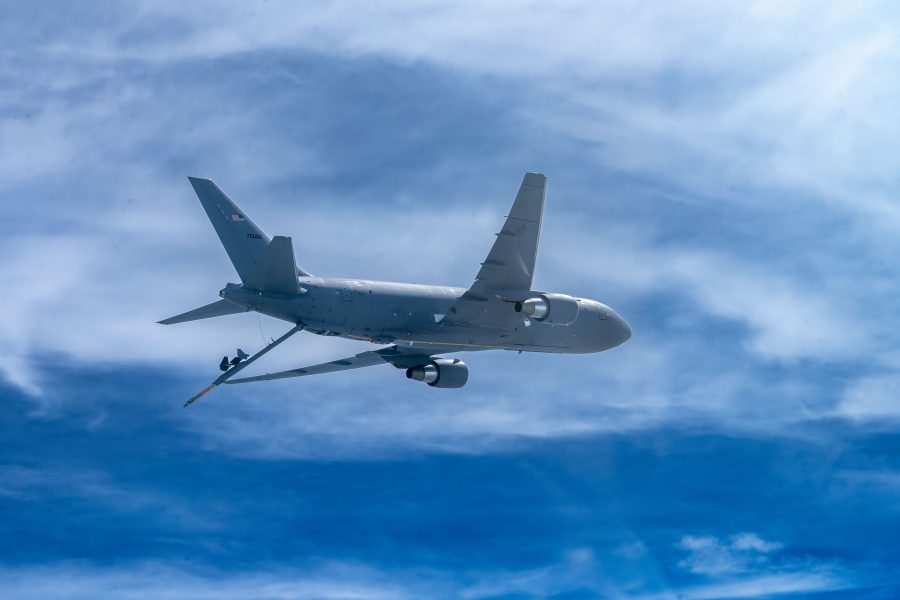Boeing received a $2.47 billion Air Force contract Nov. 25 for 15 more KC-46s, bringing to 183 the number of Pegasus tankers on contract to all customers, foreign and domestic. The new contract—for Lot 12 of the initially planned KC-46 buy—is to be completed by 2029.
The Air Force initially planned to acquire 179 KC-46s under the so-called “KC-X” program but has since boosted the number to 188, meaning there’s just one more lot to get all those originally planned jets under contract in fiscal 2026. Last summer, though, the service decided to skip a so-called “bridge tanker” competition to add another 75 KC-46s to the fleet while the Air Force develops a new, potentially stealthy tanker called the Next-Generation Air refueling System, or NGAS.
With those additional jets, the Air Force’s KC-46 fleet will eventually number about 263, and be in production through at least the mid-2030s. The Air Force is calling the program to add the additional 75 jets the “Tanker Production Extension.”
“Getting on contract helps ensure production stability, including our long-lead supply chain, to continue delivering the unmatched capability of the KC-46A,” Jake Kwasnik, vice president and KC-46 program manager, said in a Boeing press release.
The KC-46, which Boeing developed and built under a fixed-price contract, has proven far more technologically challenging than the company expected, and Boeing has had to absorb more than $7 billion in losses on the program. The company lowballed its initial bid for the jet, expecting to make up the extra costs through foreign sales, but so far it has only sold 10 overseas: six to Japan, which are in service, and four to Israel.
The Air Force has taken delivery of 98 KC-46s so far.
This year, problems with cracks in the wings led to a halt in KC-46 deliveries from March to May, at which point it was decided the issue did not pose a safety of flight issue.
Among the more persistent issues with the KC-46 is the Remote Viewing System, by which the boom operator—who is positioned directly behind the cockpit—conducts refueling via a 3D camera system. After Boeing corrected early problems with the RVS, the availability of newer technology led the Air Force to share costs with Boeing to improve the system, and the RVS 2.0 is expected to be fielded by the summer 2027; two years later than planned and four years later than originally expected. The Air Force said it’s working on ways to mitigate the delay.
Former Chief of Staff Gen. David Allvin told the House Appropriations Committee earlier this year that other issues—a stiff refueling boom, environmental control glitches, and other problems—will be fixed more quickly.
Air Force officials said it hasn’t been decided yet whether the 75-airplane production extension will again be a fixed-price or cost-plus contract, allowing Boeing to recoup some of its overages.
The tanker program has seen more turbulence than most the Air Force has pursued this century. In the early 2000s, the service tried to do a lease-to-buy arrangement on Boeing KC-767 tankers, but this idea was shot down by Congress, which preferred an outright purchase of aircraft. A first attempt at a “KC-X” competition led to the selection of Northrop Grumman/Airbus in 2008, offering a variant of the A330 Multi-Role Tanker Transport (MRTT) the Air Force dubbed the KC-45. Boeing successfully protested the award, though, and a new competition was ordered. Boeing won the re-run contest in 2011.
The Air Force has since dropped its planned “KC-Y” and “KC-Z” contests—intended to replace the remainder of the KC-135 and KC-10 fleets—in favor of the KC-46 buy extension and NGAS, expected to yield a tanker able to operate in contested airspace circa 2035.
Allvin has said the NGAS may not be a single aircraft, but a family of systems, and some of its funding may go to making the KC-46 more survivable and functional as a flying communications node and relay.
Air Force leaders have said they are generally pleased with the KC-46’s performance and that the new tanker was among those that refueled the strike package used in Operation Midnight Hammer, the raid on Iran’s nuclear enrichment and development facilities in June.


